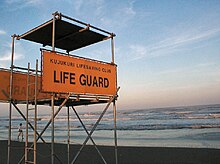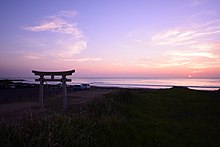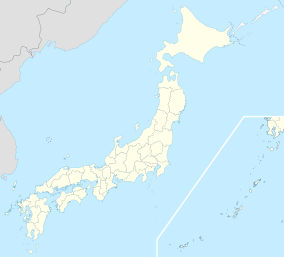Kujūkuri Beach (九十九里浜, Kujūkuri-hama) is a sandy beach that occupies much of the northeast coast of the Bōsō Peninsula in Chiba Prefecture, Japan.[1][2] Kujūkuri Beach is a popular swimming and surfing destination for inhabitants of Greater Tokyo.[3][4] The beach is protected as part of Kujūkuri Prefectural Natural Park.[1]
| Kujūkuri Beach | |
|---|---|
| 九十九里浜 Kujūkuri-hama | |
IUCN category V (protected landscape/seascape) | |
 Aerial view, from south to north, of Kujūkuri Beach | |
| Location | Chiba Prefecture, Japan |
| Coordinates | 35°31′44″N 140°27′07″E / 35.529°N 140.452°E |


The beach is approximately 60 kilometres (37 mi) long, making it the second longest beach in Japan.[5]
Geography
editKujūkuri Beach extends in the shape of an arc from Cape Gyōbumi in Asahi to the north to Cape Taitō in Isumi, Chiba Prefecture to the south.[4][6] The beach is relatively straight, in contrast to the typically irregular coastlines of Japan.[7] The tides and the Kuroshio Current create sand deposits along the length of the beach which form sand dunes of 4 metres (13 ft) to 6 metres (20 ft).[1] Kujūkuri Beach has no reef.[7]
The coastal region of the beach is the north-eastern end of Kuroshio Current influence in Japan.
Municipalities
editKujūkuri Beach extends across ten municipalities in Chiba Prefecture. They include:
Etymology
edit"Kujūkurihama" literally means "ninety nine ri (sandy) beach." Minamoto no Yoritomo was thought to order the measurement of the beach, and 99 arrows were stuck on the sand—one every ri.[1] The unit "ri" was then 6 chō (approx. 660 m), but later the ri extended to 36 chō (ca. 3.9 km). The short ri of 6 chō has long been forgotten or not in use, thus today many believe and explain incorrectly that 99 is just an inference of its long distance. The actual length of the beach is approximately 66 km, making the original measurement by Minamoto no Yoritomo an accurate one.
History
editThis section needs expansion. You can help by adding to it. (November 2009) |
In the Edo period (1603 – 1868) a new fishing net technology was brought from Kii Province, a province that covered present-day Wakayama Prefecture, as well as the southern part of Mie Prefecture. Seine fishing was introduced via trade maritime routes along the Kuroshio Current. Seine fishing, whereby a fishing net hangs vertically in the water with its bottom edge held down by weights, its top edge is buoyed by floats, and is held by fishermen or boats at either end. The introduction of seines allowed for the large-scale fishing of sardines in the region. Kujūkuri Beach became a noted center for the production of hoshika, or dried sardines. After the beginning of the Meiji period in the 19th century motorboats were used to support the net.[1]
In the last days of World War II, the Allied forces planned to land on Kujūkuri Beach in Operation Coronet. Japan's failure to complete the beach's defences on schedule contributed to Emperor Hirohito's decision to surrender.[8]
Kujūkuri has been a major location regarding Japanese surfing, particularly at Taito Beach.[9] The inaugural tournament of surfing at the Olympics happened in 2021 at Tsurigasaki Beach, located at the southern end of the beach in Ichinomiya.[10]
Flora and fauna
editA northern species chum salmon returns to a river of the beach every year, the southernmost in Japan. According to a programme of NHK, Kujūkuri is the best place in Japan to observe the sanderling. These tiny birds can be seen on most spring and autumn days following the ebb and flow of the waves at amazing speeds in search of food.[11] Kujūkuri Beach is a noted area for sardine fishing.[3][6] Japanese black pines have been planted along the length of the beach to prevent erosion.[1]
In popular culture
editThe song Omoide no Kujukurihama (Kujukuri Beach of Memories), by girl group Mi-Ke, peaked at #5 on Oricon and 32 overall on the Japanese record charts in 1991, and was the theme song for the melodrama Nurse Station on TBS. It has been covered numerous times by other performers.
See also
edit- Shichirigahama - a similarly named beach in Kanagawa Prefecture
References
edit- ^ a b c d e f "九十九里浜" [Kujūkuri Beach]. Nihon Daihyakka Zensho (Nipponika) (in Japanese). Tokyo: Shogakukan. 2012. OCLC 153301537. Archived from the original on 2007-08-25. Retrieved 2012-12-04.
- ^ "九十九里浜" [Kujūkuri Beach]. Nihon Rekishi Chimei Taikei (in Japanese). Tokyo: Shogakukan. 2012. OCLC 173191044. dlc 2009238904. Archived from the original on 2007-08-25. Retrieved 2012-12-04.
- ^ a b "Kujūkurihama". Encyclopedia of Japan. Tokyo: Shogakukan. 2012. Archived from the original on 2007-08-25. Retrieved 2012-05-14.
- ^ a b "Kujūkuri-hama". Dijitaru daijisen (in Japanese). Tokyo: Shogakukan. 2012. Archived from the original on 2007-08-25. Retrieved 2012-04-14.
- ^ "Kujukuri & Choshi / Chiba Attractions". Japan National Tourism Organization. Retrieved 27 May 2024.
The second longest beach in Japan, it offers 60 kilometers of sandy beach and clear water.
- ^ a b "Kujūkuri-hama". Nihon Kokugo Daijiten (日本国語大辞典) (in Japanese). Tokyo: Shogakukan. 2012. Archived from the original on 2007-08-25. Retrieved 2012-05-14.
- ^ a b "Kujukuri/Choushi Area". Tokyo: Japan National Tourism Organization. Retrieved Dec 4, 2012.
- ^ Bix, Herbert P. (2009). Hirohito and the Making of Modern Japan. HarperCollins. p. 515.
- ^ Wipeout of an Olympic dream
- ^ Ichinomiya: The Host Site of the Tokyo 2020 Olympic Surfing Event
- ^ Nuka, Toshimitsu; Norman, Christopher P.; Kuwabara, Kazuyuki; Miyazaki, Tatsuo (1 November 2005). "Feeding behavior and effect of prey availability on Sanderling Calidris alba distribution on Kujukuri Beach". Ornithological Science. 4 (2): 139–146. doi:10.2326/osj.4.139 – via BioOne.
External links
edit- Kujukuri Beach Area Tourist Guide (in Japanese)
